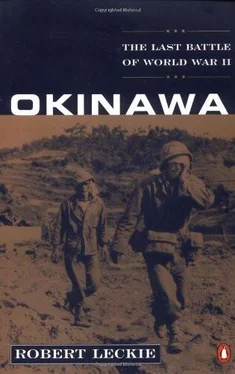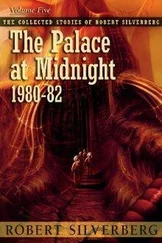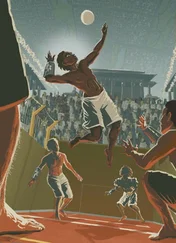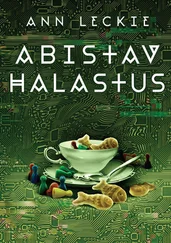No real attempt to penetrate Item was made on the first day, but on the night of the twenty-first a detail of eight men from McDonough’s battalion led by Technical Sergeant Ernest Schoeff tried to seize a ridge in a night attack, and provoked one of the wildest fights of the Okinawa campaign. Forty to fifty Japanese screaming “Banzai!” and hurling grenades charged them from about forty yards away. Scrambling into foxholes that they had dug, Schoeff’s men fought back with grenades of their own, rifle shots, rifle butts—even hurling rocks. Pfc. Paul Cook took out ten of the enemy before being killed himself, and when they closed for hand-to-hand fighting, Schoeff broke his M-1 rifle over one enemy’s head, grabbed an Arisaka rifle from another’s hands to bayonet him, and then shot a third mushroom-helmeted assailant. Wisely, the GIs made a fighting withdrawal, counting only two of their own dead and another missing. Such fierce local encounters would characterize the Item Pocket fighting lasting until April 25, and it was a company led by Captain Bernard Ryan that finally broke through the stubborn Item barrier.
On the twenty-fifth Ryan with two platoons climbed a key ridge and was savagely attacked by Japanese trying to drive them off. But they held, and then, assisted by other companies, began clearing the ridge to turn Item’s seaward flank. Nevertheless resistance continued until April 28, when Highway 1 was finally opened to southbound American traffic. Now Griner’s troops began to extend their grasp on the Urasoe-Mura Escarpment’s western flank, suffering so severely that the division’s losses rose above five hundred during a single day. By the morning of April 24, the western end of the Urasoe-Mura Escarpment was in American hands. Only Kakazu in Ushijima’s outer defenses remained unconquered. Hoping to reduce that stubborn position, Hodge formed a special attack force under Brigadier General William Bradford, the Twenty-seventh’s assistant division commander. Called “Bradford Force,” it was to strike Kakazu early on the twenty-fourth. But that night during a heavy fog a powerful enemy artillery barrage struck the American forward elements. When Bradford Force attacked, its men found to their amazement that there was little or no resistance. Under cover of the fog and the bombardment, the wily Ushijima had ordered a general retreat to preserve his remaining strength.
For five days since April 19 the Japanese had fought a dogged defensive battle, limiting the Americans’ gains to yards and at Kakazu stopping them in their tracks. But by darkness of April 23 the line had been pierced in so many places that it was in danger of collapsing with a consequent loss of many men; either by enemy action or suicide. So General Ushijima withdrew to his next chain of defenses.
In effect, the battle for southern Okinawa had advanced but a single, solid step—with many more steps to follow.
Kamikaze Bases Scourged / Kikusui 4
CHAPTER SEVENTEEN
Major General Curtis Le May had been in command of the Twentieth Air Force since the summer of 1944. At thirty-nine, this burly flier, so big he could barely fit into a fighter cockpit, was anxious to apply his theories of incendiary bombing with the new B-29 Superfortress bomber then coming off the production lines. It was not until February 1945, however, that he had enough of these gigantic aircraft to stage a major firebombing raid—this time on Kobe and with such excellent results that an ecstatic Le May prepared for the monster March 9 strike at Tokyo that became the most destructive air raid in history.
Now believing—like all those “Bomber Barons” so detested by Dwight Eisenhower—that his command alone might bring Nippon to her knees, Le May was not happy to be ordered to concentrate on the enemy air bases on Kyushu in support of the Okinawa operation. From April 16 onward the Superforts hammered the kamikaze airfields, while their chief—speaking in language customarily garbled by the cigar or pipe clenched between his teeth—appealed to General H. H. “Hap” Arnold, chief of the U.S. Army Air Force, for permission to resume strategic bombing. It was not granted, if only because Fleet Admiral Nimitz had been able to convince the Joint Chiefs that the immediate short-range effects of punishing the suicider bases would in the long run prove more valuable than the long-range results of strategic bombing.
So the Superforts continued to strike the Kyushu fields, even though Admiral Ugaki frequently used all the late-model fighters at his disposal in an effort to destroy them. This was not quite possible, for his interceptors had neither the speed nor the firepower necessary to take out a Superfort. Nevertheless, some vicious aerial duels developed high in the skies. One of the most fierce erupted on April 27 when a hundred B-29s attacked Kanoya and five other airfields. There were so many Japanese fighters aloft and buzzing the big bombers that Lieutenant Kenneth Hornbeck later told war correspondents: “The milk run is over—the cream is curdled.” Lieutenant Philip Van Schuyler reported: “They must have made a hundred attacks on the eleven B-29s that I saw, and thirty on our four-plane section.” One crippled Superfort flying out of formation was pounced on by four enemy fighters releasing white phosphorous bombs across its path. By skillful maneuver, the stricken aircraft broke clear. Four fighters fell and one Superfort was lost.
On the following day American gunners using their electronic computing gunsights claimed to have shot down thirty-six Japanese fighters together with thirteen “probables.” Again, a B-29 was lost. Using the tactics of pattern-bombing, the Americans blanketed the Kyushu fields with fragmentation and demolition bombs, cratering runways and taxiways, riddling everything erect and destroying revetments. They also struck at hangars and shops filled with planes under repair while mangling irreplaceable tools. Japanese fighters compelled to land wherever they could on Kyushu became so scattered that Ugaki and Sugahara found it almost impossible to assemble them for concentrated flights intended to clear the Okinawa skies for the following kamikaze. Thus, many more suiciders than usual were exposed to the stuttering guns of naval and Marine flyers off the carriers, and more frequently the Marine Corsairs based at Yontan and Kadena.
Nevertheless, Ugaki and Sugahara managed to put together Kikusui 4, scheduled for two main attacks April 27 and 28, and a preliminary on April 22. Le May’s attacks continued into May, and although a total of 24 Superforts were lost, with 233 damaged, the enemy’s losses in fighters, though never known exactly, were certainly astronomical. Moreover, the Superforts achieved their objective in crippling the aerial fleets of Admiral Ugaki and General Sugahara.
As often happens, either because of luck, enemy indolence, or favorable weather, the “prelim” was more destructive than the “main bout.” Twenty Navy and forty-six Army kamikaze came diving out of a haze concealing them from the gunners on the Hagushi ships. One crashed and sank a landing craft and another capsized the minesweeper Swallow. A third struck destroyer Isherwood among its depth charges aft, setting off a monster explosion that mangled the tin can’s stern and sent it crawling slowly toward Kerama. Two other destroyers suffered minor damage. There might have been much more destruction at Hagushi but for the Marine pilots at Kadena and Yontan. They reported thirty-six kills, mostly among unskillful young suiciders unable to evade their attacks. Major George Axtell on his first combat mission over the Great Loo Choo became an ace in one flight, shooting down five Vals.
On April 27 and 28 the tireless Ugaki and Sugahara managed to put 100 kamikaze into the air. Four of them were baka bombers. On the first day they struck at dusk with fighter escort, inflicting only minor damage on four near-missed destroyers. But at 8:41 P.M. the hospital ship Comfort sailing southwest of Okinawa with a full load of patients on a clear night and during a full moon with the ship lighted according to the Geneva Convention—which by policy and preference the Japanese never observed—was deliberately dive-bombed by a kamikaze. The pilot was well aware of the privileged status of his target, having dived at it in a preliminary run, before pulling up and banking to dive again. His plane and bomb crashed through three superstructure decks before exploding in the surgery compartment.
Читать дальше










